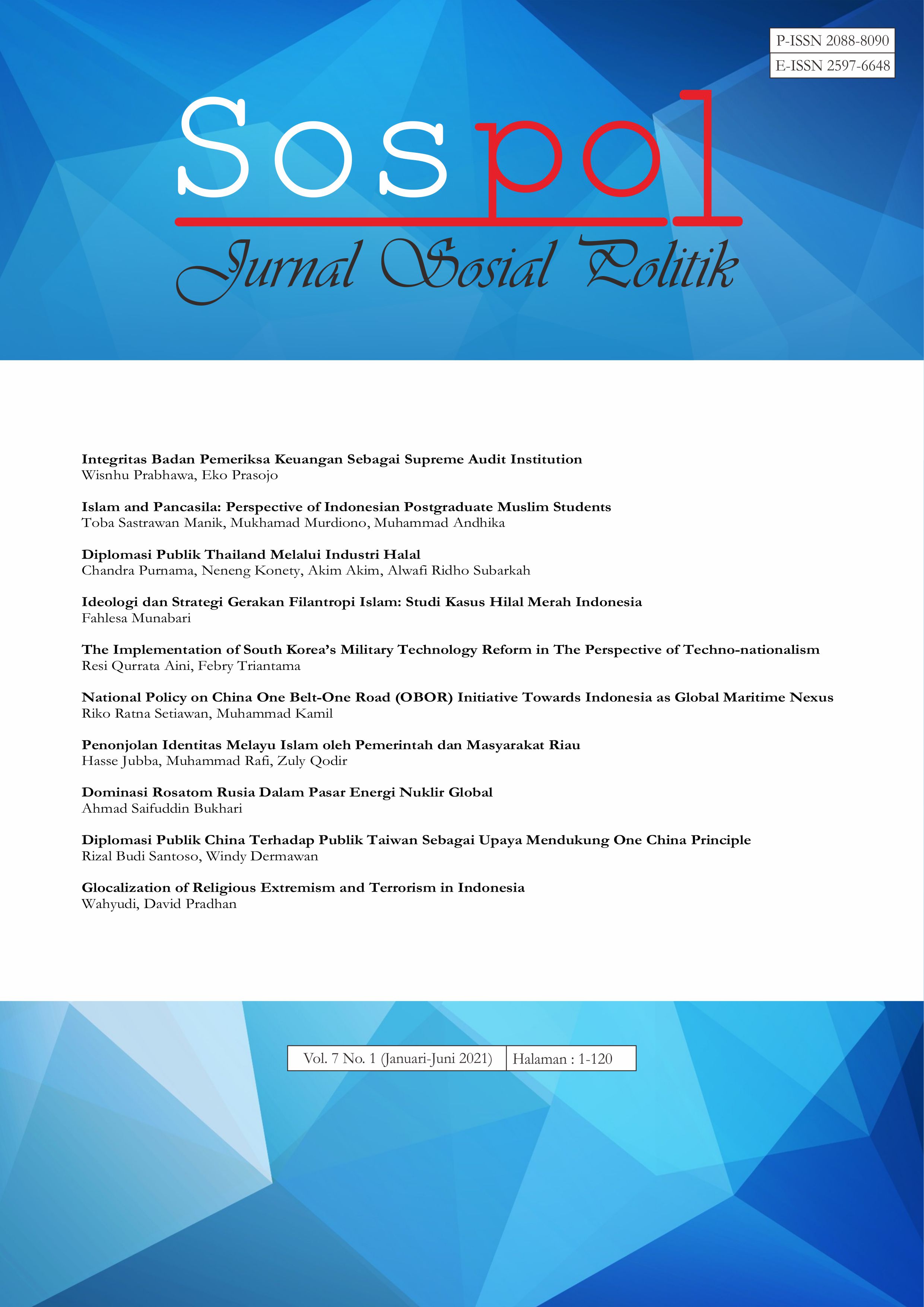The Implementation of South Korea’s Military Technology Reform in The Perspective of Techno-nationalism
DOI:
https://doi.org/10.22219/sospol.v7i1.14581Abstract
Revolution in Military Affairs (RMA) requires fundamental reforms on its 3 main pillars, namely military technology, doctrine, and organizational reform. South Korea is one of the states that has taken steps to initiate the RMA through defense reform policies. South Korea have initiated its own version of RMA by prioritizing the revolution of military technology rather than any other aspects. This article aims to explain why South Korea prioritizes its military modernization through the development of its domestic defense industry. This research applies the concept of military techno-nationalism impulse with a qualitative approach and literature review method to collect data from official documents, websites of the government, journals, and scientific reports. The results of the research indicate that South Korea's choice to prioritize the development of its domestic defense industry is not merely pushed by the urgency to decrease its dependencies toward the United States, but also by the desire to pursue for strategic power to face the North Korean threat as well as other states around the region that full of antagonism atmosphere, to obtain broader economic benefits through the spin-off effect of industrialization, and to gain international prestige as one of the largest arms exporter as well as standing equal with other regional players.
Downloads
References
Arif, M. (2016). How Threat Assessment Could Become Self-Fulfilling Prophecy: Case of U.S.-China Relations. Global: Jurnal Politik Internasional, 18(2), 120. https://doi.org/10.7454/global.v18i2.140
Bitzinger, R. A. (2003). Towards a Brave New Arms Industry. Routledge.
Bitzinger, R. A. (2015). Defense Industries in Asia and the Technonationalist Impulse. Contemporary Security Policy, 36(3), 453–472. https://doi.org/10.1080/13523260.2015.1111649
Bloomberg. (2019). Japan delaying export of key chipmaking material beyond 90-day limit, South Korea says. Japantimes. https://www.japantimes.co.jp/news/2019/10/01/business/japan-delaying-export-chipmaking-material-south-korea/#.XpfvjsgzbIU
Brookings Institutions. (2020). Korean Defense Reform: History and challenges. Brookings. https://www.brookings.edu/research/korean-defense-reform-history-and-challenges/
Chairil, T., Sinaga, D., & Febrianti, A. (2013). Relationship between Military Expenditure and Economic Growth in ASEAN: Evidence from Indonesia. Journal of ASEAN Studies, 1(2), 90. https://doi.org/10.21512/jas.v1i2.63
Chang-kwoun, P. (2018). The Moon Jae- in Administration ’ s Defense Reform 2 . 0 : Direction and Considerations. 184, 1–6.
CHANG-WOO, K., HONG-JUN, K., & KYU-SEOK, S. (2019). Korea climbs ranks of global arms exporters. Korea JoongAng Daily. https://koreajoongangdaily.joins.com/2019/08/08/politics/Korea-climbs-ranks-of-global-armsexporters/3066510.html#:~:text=Compared to 2006%2C when the,in arms and military
Deger, S., & Smith, R. (1983). Military Expenditure and Growth in Less Developed Countries. The Journal of Conflict Resolution, 27(2), 335–353. http://www.jstor.org/stable/173707
Edgerton, D. E. H. (2007). The Contradictions of Techno-Nationalism and Techno-Globalism: A Historical Perspective. New Global Studies, 1(1). https://doi.org/10.2202/1940-0004.1013
Engman, & Hannan, J. (2019). Ambition and Ambiguity: South Korea’s Defense Industry Reform. ISDP. https://isdp.eu/ambition-and-ambiguity-south-koreas-defense-industry-reform/
Feffer, J. (2009). Introduction to the Special Issue : AN ARMS RACE IN NORTHEAST ASIA ? Asian Perspective, 33(4), 5–15.
Heo, U. (1996). The Political Economy of Defense Spending in South Korea. Journal of Peace Research, 33(4), 483–490.
Holtom, P., Bromley, M., & Simmel, V. (2012). Measuring international arms transfers (Issue December). https://www.sipri.org/sites/default/files/files/FS/SIPRIFS1212.pdf
Hyung-dae, K. (2019). Next year, Korea and Russia celebrate meaningful 30th anniversary of diplomatic relations. The Korea Post. http://www.koreapost.com/news/articleView.html?idxno=9241
IISS. (2020). Military Balance. In International Institute for Strategic Studies.
Jordaan, E. (2017). The emerging middle power concept: Time to say goodbye? South African Journal of International Affairs, 24(3), 395–412. https://doi.org/10.1080/10220461.2017.1394218
Ju-Hyun, P. (2009). The ROK Defense Budget and Defense Reform. 15, 1–4.
Kim, S. (2019). Japan Delays Export of Key Chipmaking Material to South Korea. Bloomberg. https://www.bloomberg.com/news/articles/2019-09-19/japan-delays-export-of-key-chipmaking-material-to-south-korea
Korea Aerospace Industries Association. (2015). Korea Aerospace Industry 2015. 64. https://www.flandersinvestmentandtrade.com/export/sites/trade/files/market_studies/28150507103312/28150507103312_3.pdf
Korkmaz, K., & Rydqvist, J. (2012). The Republic of Korea : A Defence and Security Primer. In FOI.
Krause, K. (1991). Military Statecraft: Power and Influence in Soviet and American Arms Transfer Relationships. International Studies Quarterly, 35(3), 313. https://doi.org/10.2307/2600702
Lamont, C. (2015). Research Methods in Politics and International Relations. Sage Publications.
Liu, H. (1993). The Sino-South Korean Normalization: A Triangular Explanation. Asian Survey, 33(11), 1083–1094. https://doi.org/10.2307/2645001
Moon, C. (1991). THE POLITICAL ECONOMY OF DEFENSE INDUSTRIALIZATION IN SOUTH KOREA : CONSTRAINTS , OPPORTUNITIES , AND PROSPECTS. The Journal of East Asian Affairs, 5(2), 438–465.
Moon, C., & Lee, J.-Y. (2008). The revolution in military affairs and the defence industry in South Korea. Security Challenges, 4(4), 117–134.
Neuman, S. G. (2010). Power, influence, and hierarchy: Defense industries in a unipolar world. Defence and Peace Economics, 21(1), 105–134. https://doi.org/10.1080/10242690903105398
Neuman, W. L. (2004). Basics of Social Research: Qualitative and Quantitative Approaches. Pearson.
Neuneck, G., & Alwardt, C. (2008). The revolution in military affairs: Its driving forces, elements, and complexity. In The Revolution in Military Affairs, its Driving Forces, Elements and Complexity? (No. 13; IFAR Working Papers). https://doi.org/10.1002/cplx.20236
Oi-Hyun, K. (2017). Reports point to a new arms race breaking in the Asia Pacific region. Hani.Co.Kr. http://english.hani.co.kr/arti/english_edition/e_international/731678.html
Paul Dunne, J. (2013). Military Keynesianism: An assessment. Contributions to Conflict Management, Peace Economics and Development, 20(PART2), 117–129. https://doi.org/10.1108/S1572-8323(2013)00020.2011
Raska, M. (2011). RMA diffusion paths and patterns in South Korea’s military modernization. Korean Journal of Defense Analysis, 23(3), 369–385.
Robertson, J. (2017). Middle-power definitions: confusion reigns supreme. Australian Journal of International Affairs, 71(4), 355–370. https://doi.org/10.1080/10357718.2017.1293608
Shin, M. (2021). Conflict Between South Korea and Japan Surges Again With Court’s ‘Comfort Women’ Decision. The Diplomat. https://thediplomat.com/2021/01/conflict-between-south-korea-and-japan-surges-again-with-courts-comfort-women-decision/
South Korea Ministry of Defense. (2002). Gukbang Jeongchaik (National Defense Policy) 1998 - 2002.
South Korea Ministry of Defense. (2018). Defense White Paper.
South Korea Ministry of Defense. (2020). Establishment of Military Trust in Inter-Korean Relations. Defense Policy. https://www.mnd.go.kr/mbshome/mbs/mndEN/subview.jsp?id=mndEN_030200000000
Spero, J. B. (2009). Great power security dilemmas for pivotal middle power bridging. Contemporary Security Policy, 30(1), 147–171. https://doi.org/10.1080/13523260902760355
Tan, A. (2011). East Asia’s Military Transformation: The Revolution in Military Affairs and its Problems. Security Challenges, 7(2), 71–94.
Triantama, F., & Pangestu, Y. (2020). Revolution in Military Affairs : Strategi Menghadapi Strategic Disadavantage Singapura. Nations State: Journal of International Studies, 3(2), 195–206.
US Department of State. (n.d.). FOREIGN RELATIONS OF THE UNITED STATES, 1969–1976, VOLUME I, FOUNDATIONS OF FOREIGN POLICY, 1969–1972. Office of the Historian. https://history.state.gov/historicaldocuments/frus1969-76v01/d29
Wezeman, P. D., Fleurant, A., Kuimova, A., Tian, N., Wezeman, S. T., & The. (2019). Trends in international Arms Transfer (Issue March). https://doi.org/10.1016/b978-0-08-101276-5.00003-x
Willett, S. (1997). East asia’s changing defence industry. Survival, 39(3), 107–134. https://doi.org/10.1080/00396339708442929
Young-sup, H. (2006). Analyzing South Korea’s Defense Reform 2020. The Korean Journal of Defense Analysis, 18(1), 111-134.
Downloads
Published
How to Cite
Issue
Section
License
Copyright (c) 2021 Resi Qurrata Aini, Febry Triantama

This work is licensed under a Creative Commons Attribution-NonCommercial-ShareAlike 4.0 International License.
Authors who publish with this journal agree to the following terms:
- Authors retain copyright and grant the journal right of first publication with the work simultaneously licensed under a Creative Commons Attribution-ShareAlike 4.0 International License that allows others to share the work with an acknowledgement of the work's authorship and initial publication in this journal.
- Authors are able to enter into separate, additional contractual arrangements for the non-exclusive distribution of the journal's published version of the work (e.g., post it to an institutional repository or publish it in a book), with an acknowledgement of its initial publication in this journal.
- Authors are permitted and encouraged to post their work online (e.g., in institutional repositories or on their website) prior to and during the submission process, as it can lead to productive exchanges, as well as earlier and greater citation of published work (See The Effect of Open Access).

This work is licensed under a Creative Commons Attribution-ShareAlike 4.0 International License.



















